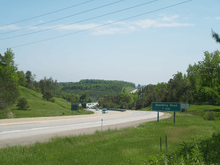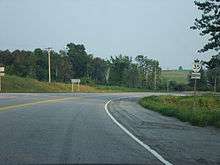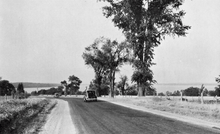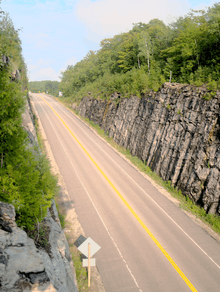Ontario Highway 35
King's Highway 35, also known as Highway 35, is a provincial highway in the Canadian province of Ontario, linking Highway 401 with Peterborough, Kawartha Lakes, and Algonquin Park. The highway travels from west of Newcastle, through Lindsay and the Kawarthas and into Haliburton before terminating at Highway 60 to the west of Algonquin Park, the province's largest. The winding course of the highway, combined with the picturesque views offered along its length, have led some to declare it the most scenic highway in Ontario.[2]
| ||||||||||
|---|---|---|---|---|---|---|---|---|---|---|

Highway 35 highlighted in red | ||||||||||
| Route information | ||||||||||
| Length | 195.6 km[1] (121.5 mi) | |||||||||
| Existed | 1931–present | |||||||||
| Major junctions | ||||||||||
| South end | ||||||||||
| North end | ||||||||||
| Location | ||||||||||
| Counties | Durham Kawartha Lakes Haliburton Highlands Muskoka | |||||||||
| Towns | Newcastle, Orono, Lindsay, Coboconk, Minden, Carnarvon, Dorset, Dwight | |||||||||
| Highway system | ||||||||||
| ||||||||||
Most of the highway, including a portion of today's Highway 60, was assumed by the Department of Highways by 1940. In 1961, Highway 115 was signed concurrently with Highway 35 for 19 kilometres (12 mi). This was widened to a divided expressway in the late eighties. In the mid-1950s, several bypasses were constructed to divert Highway 35 away from town centres such as Lindsay, Fenelon Falls and Minden.
Highway 35 is patrolled along its entirety by the Ontario Provincial Police. The speed limit for most of the length of the highway is 80 kilometres per hour (50 mph), slowing to 50 km/h (31 mph) within built-up areas, and increasing to 90 km/h (56 mph) when it connects with Highway 115.
Route description

Highway 35 begins at a trumpet interchange with Highway 401, and is concurrent with Highway 115 for 18.9 km (11.7 mi) to Enterprise Hill.[3][4][5] For the length of this concurrency, it is a divided four lane expressway with no left turns, known as right-in/right-out (RIRO). Here, Highway 35/115 meets the eastern terminus of Highway 407 at a modified trumpet interchange in Clarington. At Enterprise Hill, Highway 35 exits the divided highway (which continues as Highway 115 east to Peterborough) and proceeds north as a two lane road.[6] The highway crosses the Oak Ridges Moraine as it passes into the City of Kawartha Lakes.[7] The terrain flattens approaching Lindsay, which the highway bypasses.[3] Between Lindsay and Coboconk, the route is generally straight and crosses through a mix of agricultural lands and forest. After passing through Coboconk, it descends from the flat limestone plateau into the rocky Canadian Shield south of Norland.[7] The highway hugs the Gull River north of Norland and cuts through granite along its route into the Haliburton Highlands.[7][8] After passing Minden, the scenic highway begins diving into valleys and along cliffs overlooking several lakes.[9]

Highway 35 generally follows the former Bobcaygeon Colonization Road north of Minden, though several realignments over the years have led to its current winding route. At Carnarvon, it meets with Highway 118. [9] Heading northward into increasingly mountainous terrain, the highway crosses into Muskoka near Dorset, and shortly thereafter reaches its terminus at Highway 60 west of Algonquin Park.[8]
Traffic volumes on Highway 35 vary considerably over the length of the highway, as well as over the course of the year due to its use for recreational purposes, including snowmobiling, cottaging and camping. Along the Highway 35 and Highway 115 concurrency, the average daily vehicle count is above 20,000. This drops as Highway 35 splits off at Enterprise Hill to under 10,000. This volume is fairly consistent as far north as Minden, at which point the vehicle count drops below 5,000 and tapers off as low as 2,000 at Highway 60.[1]
History

Highway 35, like many highways that begin at Lake Ontario and eventually cross into the Canadian Shield, began as several trails connecting settlements.[10] Most of the southern portion of the highway follows various sidelines and concessions.[8] Between Lindsay and Fenelon Falls, Highway 35 follows the former Fenelon Road, while north of there it follows The Cameron Road, a trail carved in the 1850s between Fenelon and Minden. North of Minden, the highway generally follows The Bobcaygeon Road, a colonization road built as far north as Dwight in the 1850s.[11]
The Highway 35 designation was first applied in 1931 to the road between Lindsay and Fenelon Falls. In 1934 it was extended along the road between Fenelon Falls and Rosedale,[12] bringing the length of the highway up to 38.9 km (24.2 mi). The Department of Northern Development had meanwhile spent the early 1930s upgrading the trails north of the Trent–Severn Canal that fell under their jurisdiction. A new road was constructed north of Dorset as part of the Ontario Northern Highways Program,[10] avoiding the straight Bobcaygeon Road.[11] The entire route from Rosedale to Huntsville became part of Highway 35 on April 1, 1937 when the Department of Northern Development merged into the Department of Highways,[10][13] adding 138.4 km (86.0 mi) to the route. Finally in 1938, Highway 35 was extended south to Newcastle.[12]

At this point, much of the assumed route was a gravel road. Only the section south of Orono was paved. The Lindsay to Norland section was paved in the 1940s, and north of that point beginning in 1954. It would take until 1958 for paving to commence south of Lindsay.[12]
In 1953, Highway 115 was built as a two lane road eastward from Highway 35 near Pontypool.[12] It was completed to Peterborough by 1954,[14] and co-designated with Highway 35 southwards in 1961.[12][15] Construction began to widen both to four lanes beginning in 1984,[16] which was completed in the late 1980s and early 1990s.[17] The concurrency with Highway 60 was removed from Highway 35 after 1961,[18] but before 1969.[19]
Beginning in 1954, several bypasses were constructed around the towns and villages along the route.[12] The first of these was in Minden, bypassing the old route along the Bobcaygeon Road and South Water Street.[20] This was followed by the bypassing of Fenelon Falls in 1955. Highway 35 followed present day Kawartha Lakes Road 121 and Kawartha Lakes Road 8 into and out of the village until the Seventh Concession Line was paved and the highway rerouted onto it.[10][21] In 1956, Newcastle was bypassed and Highway 35 connected directly to the then eastern terminus of Highway 401 west of the village.[12] The former route is now Durham Regional Road 19.[8] By 1958, construction had begun on several bypasses of Lindsay,[22] including the Lindsay Bypass that Highway 7 and 35 follow today. Prior to the opening of the bypass, Highway 35 followed Lindsay Street to Kent Street and jogged northwest along William Street and Colborne Street. It then followed today's Kawartha Lakes Road 4 north and west to the current intersection with Highway 35. This routing became Highway 35B when the bypass opened in 1959.[12][23] In the 1960s, the route through Pontypool (now known as John Street) was bypassed.[12]
Prior to 2007, the highway was extensively rehabilitated between Kawartha Lakes Road 121, near Fenelon Falls and Highway 118 in Carnarvon. This included widening the highway for a third passing lane, as well as the resurfacing of several sections.[24]
On the day before Remembrance Day, 2009, the section of Highway 35 between Lindsay and Norland was renamed the Midland Regiment Commemorative Highway, in honour of veterans of World War II. Signs are placed along the highway at regular intervals to acknowledge the designation.[25] On April 25, 2012, four bridges along the highway were renamed in memory of police officers killed in the line of duty: The Constable Randall F. Skidmore Bridge over the Trent–Severn Waterway in Rosedale; the Constable Eric Nystedt Bridge over the Gull River in Moore Falls; and the Corporal James Smith Bridge and Detective Sergeant Lorne J. Chapitis Bridge between Miners Bay and Minden.[26][27]
Future
The MTO is currently performing an environmental assessment on Highway 35 between the Highway 115 split and Lindsay, in preparation for a four-lane expansion.[28][29] Work has also commenced on the widening of the Lindsay Bypass section of Highways 35 and 7 from two lanes to four.[30]
Major intersections
The following table lists the major junctions along Highway 35, as noted by the Ministry of Transportation of Ontario.[1]
| Division | Location | km[1] | mi | Destinations | Notes |
|---|---|---|---|---|---|
| Durham | Newcastle | 0.0 | 0.0 | Beginning of divided highway; southern end of | |
| Lovekin Road | No access across highway | ||||
| 1.3 | 0.81 | | |||
| Clarington | 4.2 | 2.6 | Clarke 3rd Concession | ||
| 6.2 | 3.9 | Clarke 4th Concession | |||
| Orono | 8.1 | 5.0 | Southbound exit and entrance; northbound exit, access to Main Street via Clarke 5th Concession | ||
| 8.6 | 5.3 | Station Street | No access across highway | ||
| 10.2 | 6.3 | Mill Street | Southbound exit and entrance | ||
| Tamblyn Road | Northbound exit and entrance | ||||
| Co-Op Road Clarke 6th Concession | Southbound exit and entrance | ||||
| 9.9 | 6.2 | Clarke 6th Concession | No access from southbound 35/115 to Clarke 6th Concession; No access to southbound 35/115 | ||
| Clarington | 13.4 | 8.3 | Clarke 7th Concession | ||
| Opened on December 9, 2019[31][32] | |||||
| Clarke 8th Concession | |||||
| Skelding Road | Southbound exit and entrance | ||||
| Beaucage Road | Southbound entrance | ||||
| Wilcox Road | Northbound exit and entrance | ||||
| Enterprise Hill | 18.9 | 11.7 | Northern end of | ||
| Manvers | 20.4 | 12.7 | |||
| Pontypool | 22.9 | 14.2 | |||
| 30.5 | 19.0 | Southern end of | |||
| 32.0 | 19.9 | Northern end of | |||
| 39.1 | 24.3 | ||||
| 40.6 | 25.2 | ||||
| Lindsay | 50.0 | 31.1 | Beginning of | ||
| 55.5 | 34.5 | End of | |||
| 56.3 | 35.0 | End of | |||
| 59.5 | 37.0 | ||||
| 62.9 | 39.1 | ||||
| Cameron | 67.2 | 41.8 | |||
| 72.4 | 45.0 | Formerly | |||
| 76.6 | 47.6 | Formerly | |||
| 77.4 | 48.1 | ||||
| Coboconk | 92.5 | 57.5 | |||
| 92.9 | 57.7 | ||||
| 93.7 | 58.2 | Formerly | |||
| Norland | 101.4 | 63.0 | Formerly | ||
| Haliburton | Minden Hills | 111.8 | 69.5 | County Road 2 (Deep Bay Road) | |
| Minden | 126.0 | 78.3 | County Road 121 – Kinmount | Formerly | |
| 128.7 | 80.0 | County Road 16 (South Lake Road) – Gelert, Lochlin County Road 2 (Newcastle Street) | |||
| 130.5 | 81.1 | County Road 21 – Haliburton Village | Formerly | ||
| Carnarvon | 143.6 | 89.2 | |||
| Halls Lake | 154.2 | 95.8 | County Road 13 (Little Hawk Lake Road) | ||
| Ox Narrows | 160.4 | 99.7 | County Road 11 (Kushog Lake Road) | ||
| Dorset | 177.9 | 110.5 | District Road 117 – Bracebridge | Formerly | |
| County Road 39 (Main Street) | |||||
| County Road 8 (Kawagama Lake Road) | |||||
| Muskoka | Lake of Bays | District Road 21 (Fox Point Road) | |||
| Dwight | 195.6 | 121.5 | |||
1.000 mi = 1.609 km; 1.000 km = 0.621 mi
| |||||
References
- Sources
- Ministry of Transportation of Ontario (2008). "Annual Average Daily Traffic (AADT) counts". Archived from the original on July 6, 2011. Retrieved February 16, 2011.
- Cantor, George (September 29, 1974). "Nature's Palette Ablaze in Canada". The Los Angeles Times. p. I-4.
Highway 35 which might be Ontario's most scenic road
- Southcentral Ontario (Map). MapArt. 2010. ISBN 978-1-55368-221-9.
- Queen's Printer for Ontario (1990). Ontario Official Road Map (Map). Government of Ontario.
- Perly's (2007). Toronto & area map book (Map). Rand McNally. p. Page 4. ISBN 978-0-88640-928-9.
- Google (May 15, 2010). "Highway 35 / 115 junction" (Map). Google Maps. Google. Retrieved May 15, 2010.
- Trent Conservation Coalition (2004). Paleozoic Region – Bedrock Topography and Geology (PDF) (Report). Ontario Ministry of Environment. Retrieved December 26, 2009.
- Ontario Back Road Atlas (Map). MapArt. 2010. ISBN 978-1-55198-226-7.
- "Haliburton County". Scenic Highway 35. CanPages. p. 38. Retrieved May 15, 2010.
- Suggitt pp. 66–67
- Shragge p. 18
- Miller pp. 97–98
- Shragge. p. 71
- Canadian Press (March 1, 1955). ""Dishonest Practices" Hid Real Highway Work—Frost". 112 (213). The Ottawa Citizen. p. 21. Retrieved May 20, 2010.
- Ontario Road Map (Map). Cartography by C.P. Robins. Ontario Department of Highways. 1961. § R35–S35.
- Annual Report 1983–1984 (Report). Ontario Ministry of Transportation and Communications. March 31, 1984. Retrieved June 24, 2010.
- Fulton, Ed (August 16, 1987). "Transport minister promises 4-lane Highway 115 by 1992". News (213). The Toronto Star. p. C.28. Retrieved May 20, 2010.
- Ontario Road Map (Map). Cartography by C.P. Robins. Ontario Department of Highways. 1961. § P34.
- Department of Highways p. 77–78
- County of Haliburton (Map). C. Tarling & Co. 1951. Retrieved June 26, 2010.
- County of Victoria (Map). C. Tarling & Co. 1951. Retrieved June 26, 2010.
- Ontario Road Map (Map). Cartography by C.P. Robins. Ontario Department of Highways. 1958. § Lindsay Inset.
- Ontario Road Map (Map). Cartography by C.P. Robins. Ontario Department of Highways. 1960. § Lindsay Inset.
- Ministry of Transportation of Ontario. "Appendix". Southern Highways Program 2007 to 2011 (Report). Government of Ontario. p. 50.
- Whitnall, Catherine (November 12, 2009). "New Highway Name Honours Regiment". MyKawartha.com. Metroland Media. Archived from the original on 15 November 2009. Retrieved October 12, 2012.
- "Backgrounder – Haliburton Area Bridges Dedicated to Fallen Police Officers" (Press release). Government of Ontario. April 26, 2012. Retrieved October 12, 2012.
- "Minden Area Bridges Dedicated To Fallen Police Officers". FYI Haliburton. April 27, 2012. Retrieved October 12, 2012.
- "Transportation & Logistics". City of Kawartha Lakes Economic Development. Retrieved May 3, 2010.
- URS Consulting Canada. Highway 35 Planning Study Site (Report). Government of Ontario. Archived from the original on September 29, 2007. Retrieved May 3, 2010.
- Ministry of Transportation of Ontario. "Greater Golden Horseshoe Expansion 2006 to 2011". Southern Ontario Highways Program 2006 to 2010 (PDF) (Report). Government of Ontario. p. 18. Retrieved May 3, 2010.
- "Chapter 8" (PDF). 407 East Environmental Assessment. p. 7. Archived from the original (PDF) on 19 July 2011. Retrieved 30 December 2019.
- "Final extension of Highway 407 now open to motorists". CTV News. Retrieved 2019-12-09.
- Bibliography
- Miller, Ray Y C (2005). "History of Highways in the Area". From Coal Oil Lights to Satellites. Trafford Publishing. ISBN 1-4120-4894-X. Retrieved June 25, 2010.
- Shragge, John; Bagnato, Sharon (1984). From Footpaths to Freeways. Ontario Ministry of Transportation and Communications, Historical Committee. ISBN 0-7743-9388-2.
- Suggitt, Gladys M. (1972). Roses and Thorns, A Goodly Heritage - The Early Days of Baddow and Area. John Deyell Co.
- AADT Traffic Volumes 1955–1969 And Traffic Collision Data 1967–1969. Department of Highways. 1969.
External links
![]()



